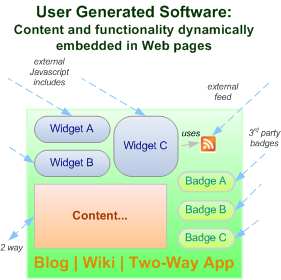Is the walled garden Web blowing apart?

My posts recently about Web 2.0 becoming a true application development platform, and one that's mostly programmed by users, generated some interesting feedback on its own. But what was more interesting was a lot of parallel discussion in the industry as others notice the same thing.

Good posts by Ian Kennedy and Susan Mernit both observed that the widgets, in the form of easily added functionality to a Web page, are growing in popularity, as well as feeds that are plugged into them. Richard MacManus even calls this rise of Web-based widgets, badges, and feed inclusion, "the new black."
Says Ian, sagely in his post:
As the traditional walled garden web blows apart, more and more small, loosely joined pieces are made available to re-configure themselves into new combinations.
Call it mashups for the rest of us - your blog or MySpace profile is a platform where you mix & match services like an events badge and content such as your linkroll. Mix it all together and add a spice of CSS for your new digital persona.
Susan agrees, saying:
Well, for one thing, widgets (and microformats) offer the opportunity for users-and small business people, among others--to embed applications and dynamic apps into their pages/sites. If you hang around myspace, you see videoplayer widgets(think youtube), slideshow players (rockyou) that have been cut and pasted in by users --and swickis, a eurekster product I worked on--are everywhere. So if you have content or tools, wouldn't you want users to be able to export them? And if you have APIs, don't you want people to build widgets with them--and then distribute those?
And while ad hoc mashup creation by users is going to become commonplace by Web-savvy users who want their information and functionality working their way, formal work is going on at the same time to make this approach even easier, more extensible, and based on real foundation.
Enter folks like Adam Cheyer and his prototypical WubHub, a novel approach at creating a true "programming environment where content, services, and applications are created, organized, extended, and shared by a distributed community in a wiki-like way." Their newly released PDF paper outlining the purposes and goals that WubHub is helping prove out is a fascinating read and I encourage all Enterprise Web 2.0 followers to give it some study.
While WubHub is still a little limited, it does exist and work today and shows the promise of the wiki for shared editing of not just content, but functionality (i.e. software) as well. Playing around with it for a while makes me think of the first time I used Ward Cunningham's eponymous Wiki Wiki site, which was the seed that started it all. You can see the potential in more than just WubHub, the Web pages, blogs, MySpace sites, and more that have a carnival of widgets, badges, and video/text feeds crawling all over them show what's possible today.
What will happen when these approaches are made workable in the enterprise? Don't ask, they largely are now. We're just waiting for the community created-context to catch up.